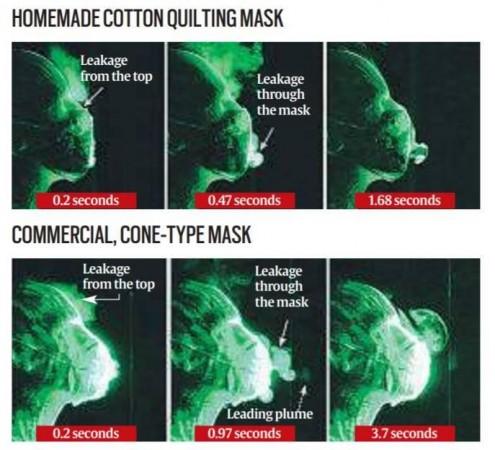
There are several guides on making face masks at home if for some reason you cannot afford or buy one N95 mask. With some basic understanding of stitching, anyone can make a face mask in a matter of a few minutes. But did you know that not all face masks are as effective and the shape of the mask and the material used in making one truly matter. It makes more sense now after hundreds of scientists raised the alarm and urged the World Health Organisation about the possibility of airborne transmission of the virus. In light of this, wearing the most effective face mask is the only way coronavirus can be contained.
Coronavirus can spread through the smallest droplets (aerosols) from the mouth that can travel as far as 6ft or more when a person coughs without a face mask, hence the importance of social distancing. But with the right kind of face mask, one can reduce the distance to which droplets can travel.
The setup
Researchers from Florida Atlantic University conducted an experiment to see how far cough particles can travel with or without a mask. Even with a mask, the research showed the importance of the right kind of face mask.
The researchers used the principles of fluid mechanics, a mannequin to stimulate coughs and laser to track the movement of ejected particles. Besides using an ideal mannequin for setup, the researchers used a pump with 500 ml mixture of distilled water and glycerine. The droplets were less than 10 microns, which is comparable to the smallest droplets in a cough.
Testing different face masks

The researchers used four different types of face masks, both in material and shape and compared the results with an uncovered mannequin. They used face masks with a loosely folded handkerchief, bandana style coverings, well-fitted homemade masks with multiple layers of fabric and a commercial cone-style mask.
The most effective face mask
The researchers published their findings in the journal Physics of Fluids. They found mannequins without any face mask projected droplets farther than 6 feet. When a loosely folded handkerchief was wrapped around, the distance was reduced 1 ft and 3 inches. With a bandana-style covering, the distance of projected droplets was 3 ft and 7 inches. A well-fitted mask with multiple layers of quilting fabric and commercial cone-style masks were most effective with results 2.5 inches and 8 inches, respectively.






!['He is done with the team now' : Angry Virat Kohli slams the bat, kicks the ground, yells at RCB team as SRH smashes runs [reactions]](https://data1.ibtimes.co.in/en/full/796956/he-done-team-now-angry-virat-kohli-slams-bat-kicks-ground-yells-rcb-team-srh-smashes.jpg?w=220&h=138)






